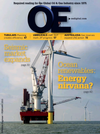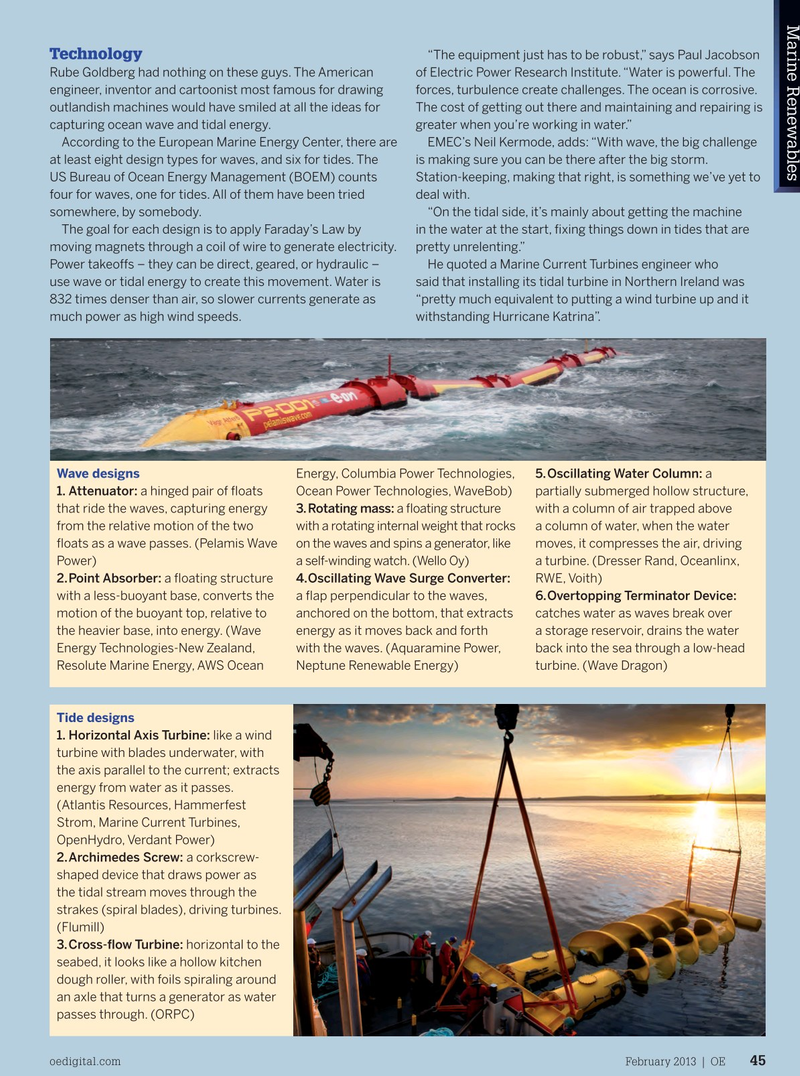
Page 43: of Offshore Engineer Magazine (Feb/Mar 2013)
Read this page in Pdf, Flash or Html5 edition of Feb/Mar 2013 Offshore Engineer Magazine
Marine RenewablesMarine Renewables
Technology “The equipment just has to be robust,” says Paul Jacobson
Rube Goldberg had nothing on these guys. The American of Electric Power Research Institute. “Water is powerful. The engineer, inventor and cartoonist most famous for drawing forces, turbulence create challenges. The ocean is corrosive. outlandish machines would have smiled at all the ideas for The cost of getting out there and maintaining and repairing is capturing ocean wave and tidal energy. greater when you’re working in water.” According to the European Marine Energy Center, there are EMEC’s Neil Kermode, adds: “With wave, the big challenge at least eight design types for waves, and six for tides. The is making sure you can be there after the big storm.
US Bureau of Ocean Energy Management (BOEM) counts Station-keeping, making that right, is something we’ve yet to four for waves, one for tides. All of them have been tried deal with. somewhere, by somebody. “On the tidal side, it’s mainly about getting the machine The goal for each design is to apply Faraday’s Law by in the water at the start, fxing things down in tides that are moving magnets through a coil of wire to generate electricity. pretty unrelenting.”
Power takeoffs – they can be direct, geared, or hydraulic – He quoted a Marine Current Turbines engineer who use wave or tidal energy to create this movement. Water is said that installing its tidal turbine in Northern Ireland was 832 times denser than air, so slower currents generate as “pretty much equivalent to putting a wind turbine up and it much power as high wind speeds. withstanding Hurricane Katrina”.
Wave designs Energy, Columbia Power Technologies, 5. Oscillating Water Column: a 1. Attenuator: a hinged pair of foats Ocean Power Technologies, WaveBob) partially submerged hollow structure, that ride the waves, capturing energy 3. Rotating mass: a foating structure with a column of air trapped above from the relative motion of the two with a rotating internal weight that rocks a column of water, when the water foats as a wave passes. (Pelamis Wave on the waves and spins a generator, like moves, it compresses the air, driving
Power) a self-winding watch. (Wello Oy) a turbine. (Dresser Rand, Oceanlinx, 2. Point Absorber: a foating structure 4. Oscillating Wave Surge Converter: RWE, Voith) with a less-buoyant base, converts the a fap perpendicular to the waves, 6. Overtopping Terminator Device: motion of the buoyant top, relative to anchored on the bottom, that extracts catches water as waves break over the heavier base, into energy. (Wave energy as it moves back and forth a storage reservoir, drains the water
Energy Technologies-New Zealand, with the waves. (Aquaramine Power, back into the sea through a low-head
Resolute Marine Energy, AWS Ocean Neptune Renewable Energy) turbine. (Wave Dragon)
Tide designs 1. Horizontal Axis Turbine: like a wind turbine with blades underwater, with the axis parallel to the current; extracts energy from water as it passes. (Atlantis Resources, Hammerfest
Strom, Marine Current Turbines,
OpenHydro, Verdant Power) 2. Archimedes Screw: a corkscrew- shaped device that draws power as the tidal stream moves through the strakes (spiral blades), driving turbines. (Flumill) 3. Cross-fow Turbine: horizontal to the seabed, it looks like a hollow kitchen dough roller, with foils spiraling around an axle that turns a generator as water passes through. (ORPC) oedigital.com oedigital.com February 2013 | OEFebruary 2013 | OE 4545 oe_renewables.indd 45 31/01/2013 10:45

 42
42

 44
44